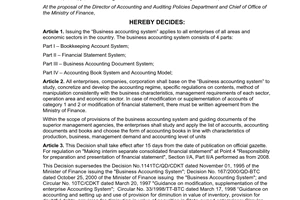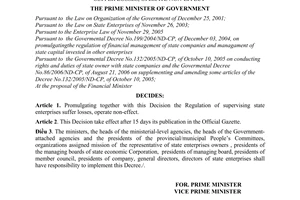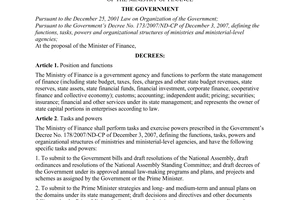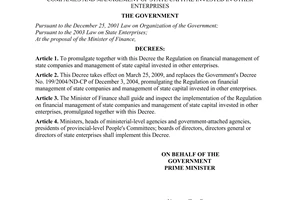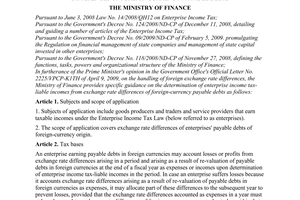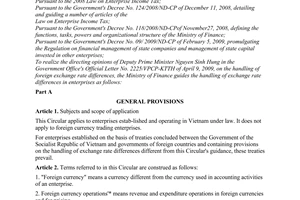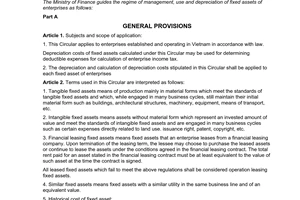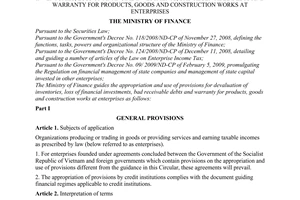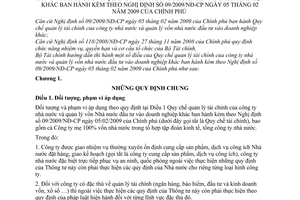Nội dung toàn văn Circular No. 242/2009/TT-BTC on guiding the implementation of a number
|
THE
MINISTRY OF FINANCE |
THE
SOCIALIST REPUBLIC OF VIETNAM |
|
No. 242/2009/TT-BTC |
Hanoi, December 30, 2009 |
CIRCULAR
ON GUIDING THE IMPLEMENTATION OF A NUMBER OF ARTICLES OF THE REGULATION ON FINANCIAL MANAGEMENT OF STATE-OWNED COMPANIES AND MANAGEMENT OF THE STATE CAPITAL INVESTED IN OTHER ENTEPRISES THAT PROMULGAGED TOGETHER WITH THE GOVERNMENT’S DECREE NO. 09/2009/ND-CP OF FEBRUARY 05, 2009
Pursuant to the Government’s Decree No. 09/2009/ND-CP of February 05, 2009 promulgating the Regulation on financial management of State-owned companies and management of the state capital invested in other enterprises;
Pursuant to the Government’s Decree No.118/2008/ND-CP of November 27, 2011 defining functions, tasks, powers and organizational structure of the Ministry of Finance;
The Ministry of Finance hereby guides the implementation of a number of articles of the Regulation on financial management of State-owned companies and management of state capital invested in other enterprises promulgated with the Government’s Decree No. 09/2009/ND-CP of February 05, 2009 as follows:
Chapter 1.
GENERAL PROVISIONS
Article 1. Subjects and scope of application
Subjects and scope of application as stipulated in Article 1 of the Regulation on financial management of State-owned companies and management of state capital invested in other enterprises promulgated with the Government’s Decree No.09/2009/ND-CP of February 05, 2009 (hereinafter referred to as the Financial Regulation) including 100% state-owned companies in the complex of state business groups and State corporations.
Of which:
1. Companies that are assigned to regularly and stably provide public-utility products and services ordered and scheduled by the State (hereinafter referred to as public-utility service and goods companies), State-owned companies that specially and directly serve public security and national defense apart from implementing this Circular, must comply with the State’s regulations particularly applicable to each type of company.
2. For companies subject to special financial management (banks, insurance companies, capital investment and trading companies, lottery companies…), apart from complying with provisions of this Circular, they shall also observe the governing provisions of law applicable to their specific sectors.
Chapter 2.
FINANCIAL MANAGEMENT OF STATE-OWNED COMPANIES
SECTION I. MANAGEMENT AND USE OF CAPITAL AND ASSETS AT STATE-OWNED COMPANIES
Article 2. Charter capital.
1. State-owned companies’s charter capital shall be approved by their owner’s representatives after reaching agreement in writing with the Ministry of Finance.
2. Principle for ensuring the charter capital:
a) Within 3 years as from the date of approval of the company’s charter capital, the State-owned company and its owner’s representative shall have a plan to supplement the charter capital with sources from operation efficiency, revenue from enterprise reorganization and conversion, or coordinate with the Ministry of Finance transferring capital from companies with redundant capital into companies with inadequate capital. After the above time limit, if the charter capital is not sufficiently supplemented the charter capital shall be decreased by the company but shall not be lower than the legal capital. In case no adjustment for the legal capital has been made, the owner’s representative shall decide on the conversion, reorganization or equitization in accordance with the stipulated regime.
b) Based on the state budget’s capacity, the State shall only ensure the charter capital for State-owned companies newly established under decisions of competent authorities and under provisions of law; State-owned companies shall be designed, invested for establishment and applied for business registration to perform the key, regular and stable target of providing public-utility services and goods ordered, scheduled or bidded by the Government for realization of public-utility service and goods volume (non-profit activities); Other cases shall be decided by the Prime Minister.
3. Methods of determining the charter capital
a) Newly-established companies
The charter capital defined in the plan for the company’s establishment shall be approved by the competent authorities; the charter capital rate shall be determined at 30% of total investment capital to ensure normal operation under its designed scale and capacity.
b) Operating companies whose charter capital hasn’t been determined
The company shall make the dossier determining its charter capital in accordance with Clause 4 of this Article to send it to the owner’s representative for approval.
The determination and approval of the charter capital shall be completed before June 30, 2010.
The company shall base on its capital demand for business and production tasks, scale and the development strategy for its main business line approved by the competent authorities to build up and submit its charter capital plan to the owner’s representative for approval under the following fomular:
Vdl = 30% (Tsxkd – Vdt + Vkh) + Vcp
Of which:
- Vdl: means the company’s charter capital.
- Tsxkd: means the total asset value used for business and production specified in the financial statement of the preceding year of the year in which the charter capital was determined and audited by the audit companies, organizations (excluding the value of public welfare assets and appropriated assets).
- Vdt: means the value of financial investment amounts of the company specified in the financial statements of the preceding year of the year of the charter capital determination which have been audited by audit companies, organizations.
- Vkh: means the capital demand for investment projects in the main business line of the company in the year of planning approved by the competent authorities under provisions of law on investment and construction.
- Vcp: means the value of capital invested in other enterpises in accordance with the plans approved by the competent authorities (including capital invested in subsidiaries of which 100% charter capital owned by the company), excluding the investment exceeding the permitted limit in other enterprises subject to investment limitation prescribed in Article 12 of the Financial Regulation.
4. The order of and procedure for determining and adjusting the charter capital.
a) For companies determining their charter capital for the first time or having demand for increasing or reducing their charter capital, based on business scale, business situation reality and function assigned by the owner’s representative, the company shall send the report on the new charter capital and to the owner’s representative.
The dossier includes:
- Plan for determining charter capital or plan for increasing the charter capital
In which, explaining:
+ The bases for determining the charter capital.
+ The capital source for supplementing the charter capital include: Profit distributed from the state capital; development investment funds; revenues from the sale of the remaining state capital portions in joint stock companies transformed from the State-owned companies in accordance with Point c Clause 4 Article 16 of the Financial Regulation, the assistance fund for enterprise reorganization at state corporations; the amount raised from the companies with redundant capital; other sources (if any).
+ The plans for return of State capital in case of reducing the charter capital or when the charter capital is less than the existing State capital.
- The audited financial statement of the previous year of the company and the financial report of the quarter closest to the time of charter capital adjustment.
- The report on deductions for and use of funds for the previous financial year of the State-owned company (under the form in Annex 1 enclosed with this Circular).
- The demand for capital ensuring projects of the main business line of the company in the year of plan approved by the competent authorities. Of which construction related projects within the main business line of the company which have been assigned under provisions of law on investment and construction (in case of charter capital increase).
- The decisions related to narrowing of business tasks (in case of charter capital decrease).
b) After the receipt of complete dossiers, the owner’s representative is responsible for appraising and sending the written request to the Ministry of Finance for consultation. Within a period of 10 working days, as from the date of receiving complete dossiers, the Ministry of Finance shall send a written agreement on charter capital and the additional source for the charter capital in order for the owner’s representative to issue the decision on approving the charter capital of the company. In case the dossier fails to satisfy requirements as prescribed, within 03 working days (after receiving the dossier), the Ministry of Finance shall notify the owner’s representative in writing of the necessary supplements to complete it.
c) In cases the Support fund for enterprise organization is used to supplement the charter capital of the company, the owner’s representative and the Ministry of Finance shall make appraisal and complete and submit the dossier to the Prime Minister for decision.
d) In case the charter capital is allocated from the state budget, the owner’s representative and Ministry of Finance shall make appraisal and report to the Government, the National Assembly (in case budget planning has not been made) for consideration and decision, After being approved by the Government and the National Assembly, the owner’s representative shall issue a decision on approving the charter capital plan which the company shall implement.
dd) Basing on the decision on approving the company’s charter capital, within 10 days, the company shall re-register its business license and notify its new charter capital in accordance with governing provisions of law.
5. Capital regulation:
Basing on the charter capital approved in accordance with Point b Clause 3 of this Article and the company’s equity, the Ministry of Finance shall coordinate with Ministries, People’s Committees of provinces and cities, the Board of Directors of the companies assigned by the State to exercise its right to represent the owner to report to the Prime Minister for consideration of and decision on the plan of capital regulation in companies with the state capital higher than the approved charter capital.
In case the company has the state capital higher than the approved charter capital, such difference shall be handled as follows:
- For independent cost-accounting member companies of state corporations, state corporations invested and established by their own member companies, the difference shall be transferred to the support fund for enterprise reorganization at the head office of the general company (or the parent company); for subsidiaries in the parent company –subsidiary model, the difference shall be transferred to the support fund for enterprise organization in the parent company.
- For state corporations or parent companies and independent State-owned companies directly managed by ministries, localities, the difference shall be transferred to the central support fund for enterprise re-organization in the State Capital Investment Corporation (SCIC) for management and use as regulated.
Particularly for the case where state capital higher than the charter capital invested in the company’s fixed asset, the company shall set up the plan for returning the state capital within 3 years; or not later than 5 years regarding companies in cultivation of perennial industrial trees such as: coffee trees, rubber trees … as from the date of decision on capital mobilization by the competent authorities. The company must send the owners' representative the plan on capital return and the report on returning capital to the state for supervision. The quarterly specific rate of capital return shall be based on the capacity to pay due debts, monetary capital balance at the end of the report period.
Within the period of 30 working days as from the date of approval of capital mobilization by the competent authorities, the State-owned company subject to capital regulation must complete the transfer of capital to the support fund for enterprise organization. After that time limit,, the company must incur an interest rate for overdue payment equal to the interest rate for overdue payment announced by the bank where the company opens its account calculated over the amount and number of dates of delayed payment.
Article 3. Capital raising
1. The company shall raise capital in accordance with Article 9 of the Financial Regulation. Of which:
a) Basing on the business task and assigned plan, the company shall determine its capital demand for business activities, development investment of the year of plan to set up its project on capital raising and use. In case the company’s project of capital mobilization makes the coefficient of the debt payable 3 times over the charter capital (for companies with the Board of Directors) or payable debts exceeding the charter capital (for companies without the Board of Directors), the company shall report to the owner’s representative for consideration and decision. The owner’s representative shall inform its decision in writing to the financial agency at the same level for monitoring and supervision.
b) The company shall utilize its raised capital in a right and effective manner. In case where false use of capital results in capital loss, the person who decides on approval of capital raising and the related persons using the raised capital shall make compensation as prescribed by law.
c) The company that has the coefficient of the debt payable 3 times over the charter capital at the end of the fiscal year for 02 successive years and fail to set up the plan for mobilization of capital exceeding the level approved by the owner’s representative, shall make a plan on restructure of capital (including: regulating capital; transfering financial investments; diversifying ownership in subsidiary and affiliated units: reorganizing the whole company – company divisions; withdrawing capital invested outside the main business line or invested inefficiently) to report it to the owner’s representative for consideration and decision.
2. Forms of capital raising
a) Issuing bonds under provisions of law.
b) Raising capital from joint venture and partnership activities.
c) Borrowing directly from individuals and economic organizations: In this case, the Company shall sign a Loan Agreement with the lenders being individuals and economic entities under provisions of law; the interest rate for capital loan must not exceed the loan interest rate announced by the commercial bank where the company opens its transaction account at the loan time; In case the company opens its transaction accounts in many banks, the interest rate for directly raised capital loan must not exceed the highest loan interest rate for the same term announced by a commercial bank where the company open its transaction account.
The State-owned company shall ensure the effectiveness of capital loan use, full payment of loan interest as committed and in accordance with the signed Loan Agreement and take responsibility for this loan.
3. The parent company is entitled to exercise its guarantee right over its 100% owned subsidiaries who wish to borrow capital from the bank and credit institutions under provisions of law. In case where subsidiaries with capital contributed by the parent company wish to be guaranteed by the parent company, the parent company shall be entitled to make the guarantee as prescribed and the following principles must be ensured:
- Capital contributors jointly commit to make the guarantee;
- The guaranteed percentage (%) of each loan shall not exceed the percentage (%) of capital contributed by the parent company into the guaranteed subsidiary and the total guaranteed amount of loan must not exceed the total capital contributed by the parent company into the guaranteed subsidiary.
Article 4. Preservation of state capital in State-owned companies
The company must report the increase and decrease of its state capital to the owner’s representation and the Ministry of Finance for monitoring and supervision.
1. The company is responsible for preserving its state capital as prescribed in Article 11 of the Financial Regulation and regularly conducting its assessment of capital use effectiveness according to the target of preservation of State-owned companies. In particular:
The level of capital return is defined as the coefficient H:
|
H = |
Value of total assets – payable debts |
|
State capital |
Of which:
- Value of total assets: Code 270 in the balance sheet.
- Payable debts: Code 300 in the balance sheet.
- State capital: the owner’s equity (Code 411 in the balance sheet); development investment fund (Code 417 in the balance sheet), capital source for fundamental construction (Code 421 in the balance sheet).
If the coefficient H > 1, the capital development has been achieved; H = 1 the capital has been preserved and if H < 1 the capital has not been preserved.
In cases the company has not preserved the state capital, the Board of Directors, the company’s Director (for companies without the Board of Directors) shall report this situation to the owner’s representative and the Ministry of Finance as prescribed in the Ministry of Finance’s Circular No. 42/2008/TT-BTC of May 22, 2008 on guiding a number of articles of the Regulation on the supervision of State-owned companies that suffer losses, operate inefficiently promulgated together with the Prime Minister’s Decision No.169/2007/QD-TTg of November 8, 2007 and shall take responsibility in accordance with Articles 32 and 34 of the Financial Regulation.
2. The deduction for and use of inventory price decrease provision, bad debt provision, financial investment loss provision, bad debt and warranty for products, goods and installation works at the companies must comply with the Ministry of Finance’s Circular No.228/2009/TT-BTC of December 7, 2009.
3. The loss transfer shall be made in accordance with governing provisions of the Law on corporate income tax.
Article 5. Investment outside State-owned companies
The company must comply with Article 12 of the Financial Regulation. Of which:
1. Other than cases where the capital contribution may not be allowed as prescribed in Clause 5 Article 12 of the Financial Regulation, the State-owned company shall be limited in the following forms of investment:
- Subsidiaries are not allowed to contribute capital to the parent companies.
- Subsidiaries, affiliated enterprises of the parent company must not contribute capital to the equitized units who are under the same group, corporation or in the same complex of the parent company –subsidiaries.
2. Each year, basing on the report on financial investment situation and effectiveness by the State-owned company, the Ministry of Finance shall coordinate with other ministries, People’s Committees of provinces and centrally-run cities in examining and supervising the management and use of state capital invested in State-owned companies in accordance with the Regulation; In case State-owned companies that make outside investments exceeding the stipulated limit or not for the right subject and fail to adjust its investment structure as prescribed by Clauses 3 and 6 of the Financial Regulation, the Ministry of Finance shall report such situation to the Prime Minister for consideration of and decision on transfer of right of representing the capital portion invested exceeding the stipulated limit or not in the right subject to the SCIC on the principle of capital reduction and increase among relevant parties.
The company subject to capital transfer shall coordinate with SCIC and economic organizations with capital contributed by the company in completing necessary procedures for transfer of right of representing the invested capital in accordance with the Prime Minister’s decision within 30 working days as from the date of the Prime Minister’s decision.
Article 6. Management and use of assets
The company shall invest in fixed assets, manage and use assets as stipulated in Section 2, Chapter II of the Financial Regulation, particularly:
1. The deduction for depreciation of fixed assets shall be made in accordance with the Ministry of Finance’s Circular No. 203/2009/TT-BTC of October 20, 2009.
2. Regarding liquidation and sale of fixed assets.
The company is entitled and responsible for liquidation of redundant assets, damaged assets that can not be recovered, technologically backward assets that are unnecessary or inefficient; sale of assets in the principles of openess and transparency, preserving capital in accordance with Clauses 2 and 3 Article 16 of the Financial Regulation, particularly:
a) In case the plan for sale of fixed assets fails to sufficiently recover the capital, the company shall report such situation to the owner’s representative and the financial agency at the same level prior to the sale of fixed assets for supervision.
b) Specifically in case the newly invested fixed assets fail to produce economic effectiveness as the approved original plan that the company does not have a demand for further use while the sale of fixed assets fails to recover sufficient capital, resulting in the failure of the company to pay debts under the loan contract or agreement, the responsibility of involved persons must be clarified and reported to the owner’s representative for handling under provisions of law.
c) The sale of fixed assets in some specialized sectors (production of tobacco, marine ships, aviation …), apart from complying with the Financial Regulation and this Circular, must be done under provisions of laws on relevant specialized sectors.
3. Sale of financial investment amounts:
Regarding the method of sale and the competence to decide on the sale of financial investment shall be implemented as prescribed in Clause 4 Article 16 of the Financial Regulation. Of which:
a) The method of sale:
Depending on the form of capital contribution, the company is entitled to transfer the financial investments in accordance with provisions of law, the charter of the enterprises invested by the company’s capital and its commitments in joint venture and partnership agreements among relevant parties.
- For the transfer of financial investment amounts at the listed companies in the securities market or companies registering transaction in UPCOM, the company shall conduct the activity in the form of order matching, auction, agreement or offer for competitive sale provided that the price must not be less than the market price at the time of sale.
- For the transfer of financial investments in joint-stock companies that have not been listed, the companies shall choose the method of auction or direct agreement to transfer in the principle of openness and transparency, capital preservation and the price not must not be lower than the market price, particularly:
+ For the transfer of financial investment amounts nominally valued at above 10 billion dong, the company must put them up for auction via the Stock Exchange. The transfer of financial investment amounts nominally valued at below 10 billion dong the company may assign an intermediary financial institutions (securities trading companies) to conduct auction or may organize an auction at its location or conduct auction through the Stock Exchange.
+ The sale agreement can only be implemented if there is only one person who register for purchase after the auction, provided that the sale price is close to the market price at the time of sale; In this case, the market price at the time of sale shall be based on the quotation of at least 3 securities trading companies who perform securities trading for enterprises with capital contributed by the company, in case no transaction has been conducted, the sale price must not be lower than that in the accounting book of the enterprise with capital contributed by the company.
b) Proceeds from the sale of partial or total remaining state capital in the limited liability company, the joint stock company which have been transformed from the subsidiary or the affiliated unit of the State-owned company (according to the decision on reorganization, transform and equalization of State-owned companies, having obtained the business license for the first time), including the deposit amount which is not payable to the investor after deducting the State capital value in the accounting book, the expense for issuance guarantee, sale expense, expense on arising taxes (if any) shall be recorded as increased capital in the State-owned company who are the owner’s representative of such enterprises. In case the state capital after exceeds the charter capital after being supplemented, the difference shall be handled in accordance with Clause 5 Article 2 of this Circular.
Article 7. Management of debts payable and debts receivable
The company is responsible for managing the debts in accordance with Articles 10 and 18 of the Financial Regulation. Of which:
- The company is entitled to sell the receivable debts under provisions of law, including the undue debts, bad debts and irrecoverable debts. Debts can only be sold through debt trading economic organizations but not directly to debtors. The sale price shall be agreed by relevant parties who shall take responsibility for their decision on sale of receivable debts. In case where the debt sale leads the company to suffer business loss, capital loss or insolvency which results in the dissolution and bankruptcy, the Board of Directors or directors (for companies without the Board of Directors) and persons who are directly involved in arising bad debts shall make compensation according to law and the relevant company’s charter.
- The reassessment of debts deriving from foreign currencies and the handling of exchange rate difference must comply with the Ministry of Finance’s Circular No.177/2009/TT-BTC of September 10, 2009 and the Ministry of Finance’s Circular No. 201/2009/TT-BTC of October 15, 2009.
SECTION II. MANAGEMENT OF TURNOVER, COST AND BUSINESS OPERATION RESULTS
Article 8. Management of turnover
Management of the company’s turnover will be carried out in accordance with Article 22 of the Financial Regulation.
Conditions and time for turnover determination
1. Conditions
- Turnover earned from the relevant period and accepted for payment by customers with valid invoices and vouches under current regulations.
- Turnover must be accounted in Vietnamese dong, in case where it is collected in foreign currencies; the turnover shall be converted into Vietnamese dong as prescribed by law.
2. Time for turnover determination
- Means the time when the company has transferred its ownership of goods and products; completed the provision of service for the buyer; completed the contract or issued the sales invoice.
- For goods and products sold through agents, turnover shall be determined when the goods consigned to the agent have been sold.
- For financial activities, the time for turnover shall be determined as follows:
+ Loan interests, deposit interests, interests earned from bond and promissory bill investment, interests on deferred payment, royalty … shall be determined according to the term of the loan contract, the leasing contract, the sales contract or the interest term.
+ Distributed dividends, profits are determined under a resolution or decision of the competent authorities.
+ Profits from the transfer of capital (except the capital transfer stipulated in Point c Clause 4 Article 16 of the Financial Regulation), profits from sale of foreign currency, foreign exchange differences earned in the relevant term of the business activities shall be determined upon the completion of these transactions or professional businesses.
Article 9. Management of expenditure
The management of expenditure shall be implemented in accordance with Article 24 of the Financial Regulation, of which:
Companies conducting monopolistic business, in addition to the financial reports made and submitted under current regulations, shall make the Report on their production and business expenses under the form provided in Annex 2 enclosed with this Circular to submit this paper to the owner’s representative and financial agencies (Services of Finance for companies managed by the local authority; the Ministry of Finance for centrally-run enterprises).
Article 10. Product costs and service expenses
1. Total costs of all products and services consumed in the relevant period as stipulated in Article 25 of the Financial Regulation.
2. Principles and methods of determining product costs and service expenses shall be subject to the following stipulations:
a) Product and service cost include:
- Expense on material, raw material, material, fuel and power directly used for production of goods and services.
- Amounts payable to labors involving in direct production such as: salary, wage and other allowances of salary nature; expense for mid-shift meals, expense for social insurance, health insurance and expense for trade union.
- General operation cost: general cost arising from workshop, business units such as: salary, wage, , expenses for mid-shift meals, cost for material, tool and equipment, expense on depreciation of fixed assets, expense on external services and other monetary expenses.
b) Total cost of consumed products and services includes:
- Cost of product and service stipulated in sub-clause a, clause 2 of this Article.
- Sales expenses including expenses arising during the sale of products, goods and services such as: salary, allowances payable to sales staff, agent commission, brokerage, marketing, packaging, preservation, transportation…, expenses on depreciation of fixed assets, expense on material, packages, tool, instrument, expense on external services and other monetary expenses.
- The company management expense: Expense for business management, administrative management and other general expenses related to the company’s operations.
Total sales expenses and company management expenses shall be carried forward to products and services consumed in that year to determine the business result.
For products produced in more than one year, the management expense arising in a year shall be allocated to the cost of semi-products.
3. The cost accounting of goods and services subject to value added taxes shall be made under current provisions of tax law.
Article 11. Profit distribution
1. The company shall comply with Article 27 of the Financial Regulation and guidances of the Ministry of Finance’s Circular No. 155/2009/TT-BTC of July 31, 2009.
2. The supplementation of charter capital by profits distributed in proportion to the state capital shall be made in accordance with Clause 4 Article 2 of this Circular.
SECTION III. FINANCIAL PLANS, REGIMES OF ACCOUNTING, STATISTIC AND AUDITING
Article 12. Financial plans
Companies shall apply Article 29 of the Financial Regulation.
1. Every year, the company shall be assigned a target plan on profit rate by state capital in the following year by the owner’s representative who at the same time sends such plan to the financial agency at the same body as a basis for supervision and assessment of business administration and management results.
2. Every year, basing on the target plan on profit rate by state capital assigned by the owner’s representative, the company shall assess the business situation of the report year and make the financial plan for the following year (under the form in Annex 3 enclosed with this Circular) to submit it to the owner’s representative and the financial agency (the Ministry of Finance for companies represented by the Prime Minister, Ministries of specific sectors being representatives of the owners; the Service of Finance for companies represented by People’s Committees of provinces and cities) before July 31st.
Article 13. Financial reports and other reports
1. The company shall comply with Article 30 of the Financial Regulation and other governing provisions of law on accounting and auditing, financial disclosure. The financial reports made under provisions of the Ministry of Finance’s Decision No.15/2006/QD-BTC of March 30, 2006 shall be added by the Form 2b-DN “Payments to the budget” as provided in Annex 4 enclosed with this Circular.
2. In addition, the company must elaborate and send reports to its owner’s representative and the financial agency (the Ministry of Finance for companies represented by the Prime Minister, Ministries of specific sectors on behalf of their owner; Service of Finance for companies represented by People’s Committees of provinces and cities) as follows:
a) Elaborate and send the Report on supervision and assessment of operation effectiveness in accordance with the Ministry of Finance’s Circular No.115/2007/TT-BTC of September 25, 2007 guiding some contents on supervising and assessing the business efficiency of the State-owned companies under the Prime Minister’s Decision No.224/2006/QD-TTg of October 06, 2006. Companies suffering losses must make and send the supervision report according to the Ministry of Finance’s Circular No. 42/2008/TT-BTC of May 22, 2005.
b) Every year, together with the financial report, the company shall make and send other reports: Report on financial investment (Annex 5 enclosed with this Circular); Report on raising and using capital (Annex 6 enclosed with this Circular); Report on distribution of profit after corporate income tax (Annex 1 enclosed with this Circular).
Chapter 3.
MANAGEMENT OF STATE CAPITAL INVESTED INTO OTHER ENTERPRISES
Article 14. Management of state capital invested into other enterprises
The management of State capital invested in other enterprises must comply with stipulations of Chapter IV of the Financial Regulation.
Article 15. Salary, allowance, bonus and interests of the representative
1. Salary, allowance, bonus and interersts of the representative must comply with Article 46 of the Financial Regulation and regulations of the Ministry of Labor – Invalids and Social Affairs.
2. In case the representative being a part-time member not participating in the specialized management board of other enterprises receiving remunerations from other enterprises is responsible to notify the enterprise of which he or she is assigned to represent the State capital in order for the enterprise to directly transfer the remuneration to the owner’s representative for management and payment as prescribed. In particular:
- The owner’s representative being the State-owned company:
+ All revenues from the remuneration paid by other enterprises of which the representative being a part-time member shall be accounted into other income of the company.
+ All allowance payable to the representative shall be accounted into other expense of the company.
- In case the owner’s representative is state management agencies, remuneration of the representative shall be separately monitored to settle the allowance paid to the representative under the regulated regime.
3. Every year, basing on the result of classification and assessment of management activities of other enterprises and the performance result of the representative, the owner’s representative shall decide on the representative’s allowance amount to individuals who are appointed to be the representative of the state capital portions as regulated.
4. Other interests of the owner’s representative: shall be exercised as prescribed in Clause 3 Article 46 of the Financial Regulation. Of which:
Representatives of the State capital portion in other enterprises obtaining the call option of additionally issued shares or convertible bonds under decisions of joint-stock companies except for the case of purchasing under the rights of existing shareholders), must report in writing to the state capital owners’ representatives.
In case a representative is appointed to represent many units, he/she shall be given priority for the call option at a certain unit.
Within 05 working days as from receiving the report, the owner’s representative of the State capital shall make written decisions on the quantity of additionally issued shares and convertible bonds that representatives may purchase. In case the quantity of shares that the representative may purchase under decision of the state capital owner’s representative is smaller than the number of shares that the representative may purchase under decision of the joint stock company, the state capital owner’s representative is entitled to buy the remaining shares. Accordingly, the representative shall submit a report in writing to the joint stock company and concurrently transfer the call option to the state capital owner’s representative. Expenses relating to the transfer (if any) shall be born by the state capital owner’s representative in proportion to the number of shares transferred from the representative to the owner’s representative. In case the state capital representative does not demand to purchase the above number of shares, such representative is entitled to transfer the right to shares purchase under governing provisions of law.
5. Reporting regime for the capital state representative in other enterprises shall be done as follows:
The representative shall:
a) Basing on financial reports and other reports of the enterprise, quarterly and in the end of each year, sum up financial targets in the form in Annex 7 enclosed with this Circular, analyze and assesses the business result, management and use of capital in the enterprise, solvency, distribution of dividends and other rights, proposals and measures to surmount difficulties to enhance the effectiveness of use of state capital invested in other enterprises.
The report must be submitted to the owner’s representative within 15 days after other enterprises send their financial reports (quarterly, yearly) under current regulations.
b) In addition to above periodical reports, the representative shall report to the state capital owner’s representative on the enterprise’s situation in case major issues arising affect the business result of other enterprises or if there is any issue needs to be consulted with the owner’s representative or upon the request of the owner’s representative.
Chapter 4.
IMPLEMENTATION ORGANIZATION
Article 16. Effect
1. This Circular takes effects 45 days as from the date of signing and shall be applied to the settlement of issues arising from the fiscal year of 2009.
2. This Circular annuls the Ministry of Finance’s Circular No. 33/2005/TT-BTC of April 29, 2005 guiding a number of the regulation on financial management of State-owned companies and management of state capital invested into other enterprises, the Ministry of Finance’s Circular No. 87/2006/TT-BTC of September 27, 2006 amending and supplementing the Ministry of Finance’s Circular No.33/2005/TT-BTC of April 29, 2005 guiding a number of the regulation on financial management of State-owned companies and management of state capital invested into other enterprises; other prior guidance’s on financial management of State-owned companies issued by the Ministry of Finance and other branches which are not conformable to guidance’s under this Circular./.
|
|
FOR
THE MINISTER OF FINANCE |
------------------------------------------------------------------------------------------------------
This translation is made by LawSoft and
for reference purposes only. Its copyright is owned by LawSoft
and protected under Clause 2, Article 14 of the Law on Intellectual Property.Your comments are always welcomed
